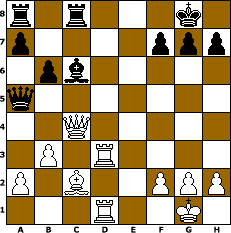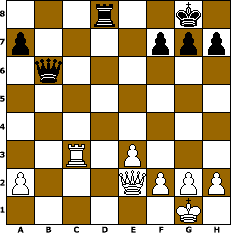In chess, a back rank mate is a checkmate delivered by a rook or queen (or some similar fairy chess piece in some chess variant) along a back rank (that is, the row on which the pieces (not pawns) stand at the start of the game) in which the mated king is unable to move up the board because the king is blocked by friendly pieces (usually pawns) on the second rank. A typical position is shown to the right.
Back rank mates occur quite often in games at fairly low levels. At higher levels of play, though the mate itself does not occur very often, play is often affected by the possibility of it - the fact that a player has to spend time guarding against the mate may leave him vulnerable to other tactical ideas.

Back rank mates are often guarded against simply by virtue of a friendly rook or queen protecting the back rank. However, it may be possible for the attacking side to deflect one of these pieces away from defensive duties. In the example shown to the left, for example, White to move can play 1.Qxc6 when black cannot reply 1...Rxc6 because of 2.Rd8+ Rxd8 3.Rxd8# with a back rank mate (these moves are given in algebraic notation). Black therefore loses his bishop for no compensation. Examples such this, where a rook cannot leave the back rank because of mate threats, are relatively common in chess.
Back rank threats can be guarded against more permanently by moving one of the pawns in front of the king to give the king a flight square (such a move is sometimes said to "give the king some luft"). If it were Black to play in the example to the left, he could counter White´s threat with (among other moves) 1...g6, giving the king a square on g7 to which he could safely move. Note, however, that 1...h6 in this example would not do the job, as after the d3 rook moves the h7 square is guarded by the white bishop.
It should be noted that it is often not a good idea to play such pawn moves unless there is a pressing need to do so, as they can represent a loss of time. In many chess openings, however, they are often played for some other purpose, before any back rank threats have emerged (...h6 is often played to bother a white bishop on g5, for example).

One of José Raúl Capablanca´s most famous games featured a variety of back rank threats at the end. It was an exhibition game played in Moscow in 1914 against Ossip Bernstein (Capablanca had the black pieces). The position shown to the right was reached after white´s 29th move. Capablanca now played 29...Qb2! The simplest point is that 30.Qxb2 is not possible because of the back rank mate 30...Rd1#, but there are several related ideas: for example, 30.Qe1, apparently defending the threatened rook, loses to 30...Qxc3 (if 31.Qxc3 then ...Rd1+ 32.Qe1 Rxe1#); 30.Rc2 fails to 30...Qb1+ 31.Qf1 Qxc2; and 30...Qc2 loses to 30...Qa1+ 31.Qc1 Rd1+ 32.Qxd1 Qxd1#.
It might also be noted that if Capablanca had played for the back rank mate more directly with 29...Qb1+ 30.Qf1 Rd1, he would himself have lost to the back rank mate 31.Rc8+.
|
